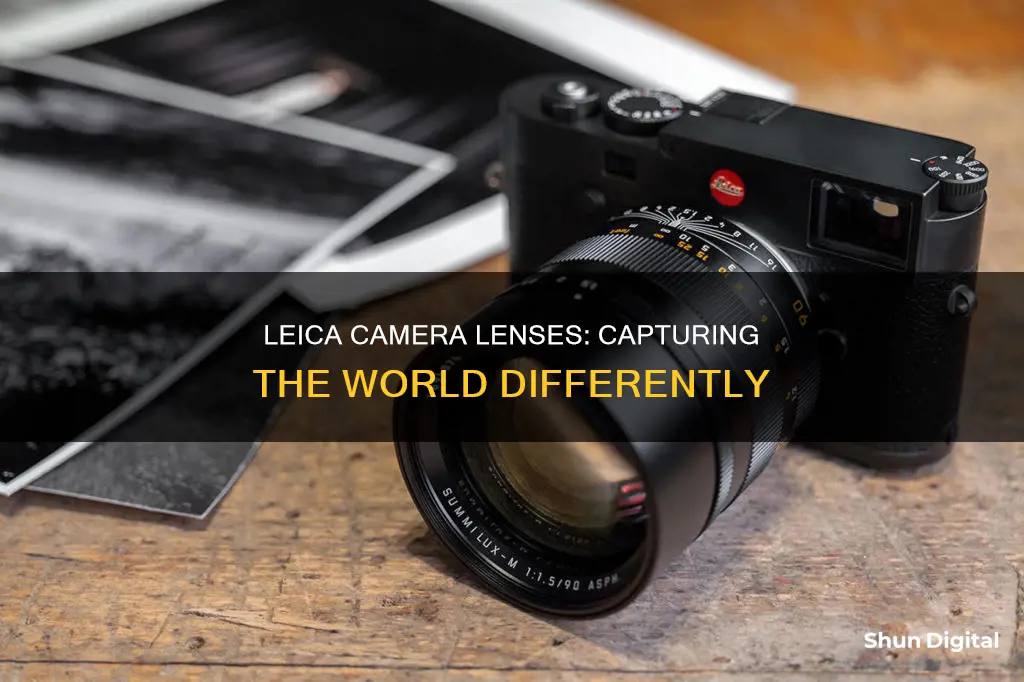
Leica Camera AG is a German company that manufactures cameras, lenses, binoculars, and rifle scopes. The company was founded by Ernst Leitz in 1869 in Wetzlar, Germany, and the name Leica is derived from the first three letters of the founder's surname and the first two of the word camera. Leica lenses are known for their high-quality materials, meticulous attention to detail, and unique rendering signatures. The company's M-System lenses, in particular, are synonymous with creative freedom and exceptional imaging performance. Leica lenses are often sought after by photographers for their build quality, simplicity, and superior image quality.
| Characteristics | Values |
|---|---|
| Company | Leica Camera AG |
| Company Type | German company manufacturing cameras, optical lenses, photographic lenses, binoculars, and rifle scopes |
| Founder | Ernst Leitz |
| Founded | 1869 |
| Place of Origin | Wetzlar, Germany |
| Current Location | Leitz Park 1, Wetzlar |
| Parent Company | Leitz (originally) |
| Owner | 55% owned by Austrian investment firm ACM Projektentwicklung GmbH and 45% owned by The Blackstone Group |
| Brand Licensee | Danaher Corporation-owned Leica Microsystems GmbH |
| Brand Value | Luxury item/status symbol |
| Camera Types | Digital and analogue; single-lens reflex cameras; compact cameras; rangefinder cameras |
| Lens Types | M-System; APO-Summicron-M; Summilux-M; Summicron-M; Tri-Elmar-M; Super-Elmar-M; Elmarit-M; Noctilux-M; APO-Telyt-M; Elmarit-M; Summaron-M; etc. |
| Lens Characteristics | Apochromatic; aspherical; apochromatic; etc. |
| Lens Compatibility | Leica M-Camera (since 1954); Leica M-Camera with full-frame; Leica M240; Leica SL; Leica CL; Leica Q; etc. |
What You'll Learn

Leica lens abbreviations and their meanings
Leica lenses are known for their exceptional quality, and the company uses a variety of abbreviations to denote the features and specifications of each lens. Here is a guide to understanding some of the most common Leica lens abbreviations and their meanings:
- APO – Refers to ''apochromatic or 'apochromatically corrected' lenses. These lenses are designed to minimise chromatic and spherical aberrations by ensuring that all colours converge at a single point of focus, resulting in sharper images without colour fringing.
- ASPH – Stands for 'aspherical design'. ASPH lenses feature at least one lens element with a non-constant radius of curvature, allowing for improved optical corrections and sharper images, even in the corners.
- M – This lineup is designated for the M-series of rangefinder cameras. M-mount lenses are manual focus and compatible with Leica's range of film and digital rangefinder cameras, as well as SL and L/TL system cameras with an adapter.
- SL – These lenses are designed for the SL series of mirrorless full-frame cameras.
- TL – The lenses are for the APS-C mirrorless cameras.
- R – Refers to the lenses designed for Leica's R-series of SLR cameras.
- S – The S lenses are compatible with Leica's medium format cameras.
- MACRO-ELMAR – This indicates that the lens is suitable for macro photography and extreme close-ups.
- NOCTILUX – These lenses have wider-than-average apertures, making them ideal for low-light or night photography.
- SUMMILUX – Often a result of a Leica-Panasonic collaboration, these lenses have a maximum aperture of f/1.4, enhancing their light-gathering abilities.
- SUMMICRON – Featuring fast f/2 apertures, these lenses represent the pinnacle of Leica's manufacturing capabilities. They are known for their exceptional sharpness and clarity.
- ELMAR – Lenses with the 'Elmar' designation typically have a maximum aperture of f/3.5.
- ELMARIT – Indicates a maximum lens aperture of f/2.8.
Leica lenses are known for their complex terminology and abbreviations, and this guide provides an insight into some of the most commonly used ones.
Sunlight and Camera Lenses: Friends or Foes?
You may want to see also

The history of Leica lenses
The Birth of Leica:
The Leica brand was established by Ernst Leitz in 1869 in Wetzlar, Germany. The name Leica is derived from the first three letters of the founder's surname, "Leitz," and the first two letters of "camera."
Early Innovations:
In the early 1900s, Leica began developing its first camera prototypes, but it wasn't until the mid-1920s that marketing and sales commenced. The Leica I, introduced in 1925, was an immediate success and set the standard for 35mm photography.
Optical Innovations:
Leica revolutionised optics with the introduction of aspherical lens design, apochromatic correction, and innovative lens coatings. These advancements improved image quality, reduced aberrations, and enhanced light transmission.
Expansion and Diversification:
Over the years, Leica expanded its lens offerings, introducing various lens series such as the Elmar, Summicron, and Summilux. They also diversified their product line to include binoculars, rifle scopes, and other optical instruments.
Technological Advancements:
Leica embraced technological advancements, incorporating computer-aided design in optical engineering in the 1970s. This led to even greater precision and innovation in lens design.
Refinement and Specialisation:
Leica continued to refine its lenses, prioritising exceptional imaging performance. They developed lenses with exceptional sharpness, crisp contrasts, and natural colour rendition, ensuring compatibility with both digital and film photography.
Return to Roots:
In 2014, Leica returned to its roots, building a new factory in Wetzlar, the city where it all began. This factory, Leitz Park 1, symbolises Leica's commitment to innovation and craftsmanship.
Leica lenses have come a long way since their inception, and the company continues to push the boundaries of optical excellence, solidifying its place as a leader in the photography industry.
Claiming Camera Equipment on Taxes: A Comprehensive Guide
You may want to see also

The science behind Leica lens design
Leica Camera AG is a German company that manufactures cameras, optical lenses, photographic lenses, binoculars, and rifle scopes. The company was founded by Ernst Leitz in 1869 in Wetzlar, Germany. The name Leica is derived from the first three letters of the founder's surname (Leitz) and the first two of the word camera: lei-ca (LEItz CAmera).
Leica lenses are known for their high-quality optics and innovative designs. The company has been responsible for numerous optical innovations over the years, including aspherical production lenses, multicoated lenses, and rare earth lenses.
One key aspect of Leica lens design is the use of apochromatic correction (APO). In normal lens designs, blue and green light converges on one focal plane, while red light is refracted to a slightly different plane, causing chromatic aberration or colour fringing. Leica's APO lenses use special lens elements and low-dispersion glass to correct this issue, resulting in sharper images with better colour accuracy.
Another feature of Leica lenses is their aspherical design (ASPH). Unlike traditional spherical lenses, aspherical lenses have a non-constant radius of curvature, allowing for more complex optical corrections and improved image sharpness, even in compact lens designs.
Leica lenses are also known for their ability to produce smooth bokeh, an aesthetic quality of the out-of-focus parts of an image. This is achieved through careful design and precision manufacturing, resulting in a pleasing blur that enhances the overall image.
In addition, Leica lenses offer a range of features and capabilities, such as central shutters, close focus distances, and distortion control, that give photographers creative freedom and flexibility in various shooting situations.
Overall, the science behind Leica lens design involves a deep understanding of optics, physics, and manufacturing processes, resulting in lenses that offer exceptional performance, sharpness, and image quality.
Minolta Lenses: Universal Fit for Minolta Cameras?
You may want to see also

Leica lens compatibility with other cameras
Leica lenses are compatible with a wide range of cameras, including both Leica and non-Leica models. Here is a detailed overview of Leica lens compatibility with other cameras:
Leica M-Lenses
Leica M-Lenses are renowned for their exceptional imaging performance and unique rendering signatures. These lenses are designed for both digital and film photography and offer exceptional sharpness, crisp contrasts, and natural colour rendition. One of the standout features of Leica M-Lenses is their compatibility with Leica M-Cameras dating back to 1954. This means that photographers can pair recent M-Lenses with vintage Leica camera bodies for creative effects. The range of focal lengths and apertures available in the M-Lens lineup also provides versatility for various photography styles.
Leica Thread Mount (LTM) Lenses
Leica Thread Mount lenses, also known as LTM lenses, were introduced in 1930 with the Leica I Schraubgewinde. These lenses featured a 39mm diameter screw thread that allowed for interchangeable lenses. While the original Leica I Schraubgewinde offered a 50mm normal lens, Leica soon expanded the LTM lineup to include a 35mm wide-angle lens and a 135mm telephoto lens. Today, LTM lenses can be used on modern Leica M cameras with a simple adapter, making them a versatile option for photographers who want to blend vintage lenses with contemporary camera bodies.
Leica R-Lenses
Leica R-Lenses were introduced in 1964 with the Leicaflex series, followed by the Leica R series from R3 to R7. These lenses were designed for single-lens reflex cameras and were produced in collaboration with the Minolta Corporation. While the Leica R-Lenses provided excellent optical quality, they lacked auto-exposure and auto-focusing capabilities, which contributed to the discontinuation of the R-series in 2009. However, with adapters, Leica R-Lenses can be used on various non-Leica camera systems, including those from Panasonic, Canon, Nikon, and Sony.
Leica L-Mount Lenses
Leica has expanded its lens compatibility options by partnering with other camera manufacturers. In 2018, Leica announced a strategic alliance with Sigma and Panasonic, allowing these companies to use the L-mount platform. This partnership has resulted in a range of L-mount lenses that are compatible with Leica, Sigma, and Panasonic camera bodies. However, it is important to note that Panasonic has stated that they cannot guarantee complete performance when using third-party aftermarket components, and some features may be limited.
Leica M-Mount Lenses
In addition to Leica's own M-Cameras, the M-Mount lenses are also compatible with mirrorless cameras from various manufacturers. With a simple adapter, photographers can use M-Mount lenses on mirrorless interchangeable lens camera systems. This compatibility opens up a world of creative possibilities, allowing photographers to blend the renowned Leica aesthetic with the latest digital camera technology.
Understanding Your Camera Lens' Field of View
You may want to see also

The unique appeal of vintage Leica lenses
Leica Camera AG is a German company that manufactures cameras, lenses, binoculars, and rifle scopes. The company was founded by Ernst Leitz in 1869 in Wetzlar, Germany, and the name "Leica" is derived from the first three letters of the founder's surname and the first two of the word "camera".
Leica has become a prestigious and recognisable name in the photography industry, largely due to the enduring appeal of its vintage cameras and lenses. The market for pre-owned Leica gear is vast and active, with Leica offering customers various avenues for purchasing vintage products, including auctions and the Leica Classic store.
One of the key advantages of vintage Leica lenses is their compatibility with modern cameras. With the right adapters, photographers can use vintage Leica lenses on newer camera bodies, allowing for creative experimentation and a unique look to their images.
Vintage Leica lenses are also prized for their build quality and mechanical engineering. The focus action and aperture control of these lenses are often described as "dreamy," contributing to a smooth and enjoyable shooting experience.
Additionally, the optical design of Leica lenses is renowned for its exceptional sharpness, crisp contrasts, and natural colour rendition. This is achieved through the use of different types of glass, aspherical lens designs, and optical corrections.
Furthermore, some vintage Leica lenses are sought after for their rarity and historical significance. The company's black paint cameras, for example, were originally designed to meet the demands of press photographers but have since become highly coveted by collectors.
In conclusion, the unique appeal of vintage Leica lenses lies in their ability to impart character to images, their compatibility with modern cameras, exceptional optical performance, and their historical significance. For photographers seeking to add a distinct look and feel to their work, vintage Leica lenses offer a wealth of creative possibilities.
Attaching Enlarger Lenses to Cameras: A Step-by-Step Guide
You may want to see also
Frequently asked questions
Leica is an acronym for LEItz CAmera, derived from the first three letters of the founder's surname (Leitz) and the first two of the word camera.
Leica lenses are made from optical glass. Leica uses approximately 100 different types of glass to produce around 360 different lens elements.
The M-System is known for its unique photographic images, creative freedom, and decisive moments. Each M lens has its own character and unique rendering signature.
Pre-aspherical Leica lenses are those made before the introduction of the aspherical lens design in 1966. Aspherical lenses correct distortions and deliver greater colour accuracy, presenting a more realistic view of a scene or subject.







